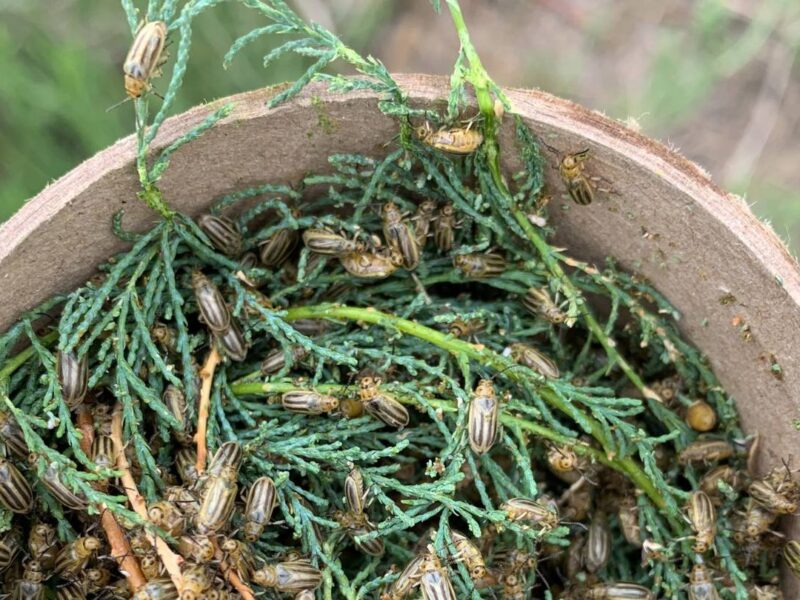Neighboring through drought: Water sharing solutions for the West
In the third installment of our 2025 Water Webinar series we focused on the successes and challenges of utilizing community-scale water sharing agreements to provide flexibility to producers and communities as they weather decreased water supplies. The panel discussion included insights from senior conservation manager Dylan O’Hare of The Palmer Land Conservancy (PLC), water steward Clancy Jandreau of The Blackfoot Challenge, and landowner Lawrence Gallegos, the Northen New Mexico Coordinator of the National Grazing Lands Coalition (NGLC). Together, they discussed what works, what doesn’t, and what landowners need to know when developing water-sharing agreements. They shared valuable insights from their on-the-ground experiences adapting to less water on the land, and how such solutions can support agricultural operations and foster community resilience in times of water scarcity.
Water Sharing Solutions
Dylan O’Hare kicked off the conversation by explaining the importance of community-driven, market-based water-sharing solutions. Water sharing agreements, like option agreements and short-term leases, can be utilized to meet various water supply challenges, such as water shortages from drought. These agreements are designed to minimize permanent reductions in irrigated agriculture and the unintended economic and ecological impacts that can cause. O’Hare explained that PLC has worked for over 45 years in southeastern Colorado’s Arkansas basin, helping landowners navigate water challenges through voluntary, innovative frameworks. PLC has worked extensively on the Bessemer Farmland Conservation Project, which emerged after a local water utility purchased shares of a local ditch from farmers. This project aims to avoid the negative impacts of “buy and dry,” where productive farms are decommissioned in favor of water sales to municipalities which can threaten rural economies. O’Hare emphasized that trust and relationships are at the core of these efforts, noting that collaboration between farmers, local communities, and municipalities is crucial in developing long-term solutions for water conservation.
Voluntary Drought Response Plans
Clancy Jandreau followed by describing Blackfoot Challenge’s successful 25-year effort to mitigate drought impacts through a voluntary drought response plan. This plan encourages shared sacrifice for shared benefit by involving all water users in the watershed, including irrigators, recreational users, and businesses. Instead of enforcing traditional water rights, participants are shielded from restrictions if they contribute to strategies that enhance water conservation efforts. Jandreau explained how the plan fosters collaboration and provides a platform for water users to work together, resulting in better water conservation and enhanced habitat protection. Over 90 participants are currently involved in the plan, which has led to increased streamflow and habitat restoration across the Blackfoot watershed. The Blackfoot Challenge has utilized their experience in the Blackfoot watershed to create a guide that provides information and best practices relating to natural resource issue and stewardship to stakeholders in the region.
Acequias in Northern New Mexico: Tradition Meets Modern Challenges
Lawrence Gallegos shared a critical landowner perspective on how Acequias, the traditional communal irrigation systems in northern New Mexico, have adapted to contemporary challenges such as drought and climate change. Emphasizing the long-standing principles of equitable distribution and shared stewardship of water, Lawrence discussed how Acequias have been vital for managing water across generations. Drawing from his experience with the San Luis Valley and the El Codo Acequia, he explained how these systems, rooted in cultural practices, not only conserve water but also support the social and cultural resilience of local communities. Despite increasing pressures from climate change, Gallegos stressed the importance of preserving these time-honored practices through collaboration among landowners, agencies, and local groups. He also highlighted how changes in grazing practices and infrastructure improvements, such as the installation of new diversion structures, have helped mitigate the effects of water scarcity. To learn more about the history and impact of Acequias, you can explore Acequia Culture in New Mexico.
Leveraging Water Sharing Agreements for Long-Term Resilience
The panel then turned to the broader question of how water sharing agreements can create sustainable solutions for working lands, particularly in the face of drought. O’Hare discussed how these agreements can address competing demands for water by optimizing its use across the landscape. For example, the Bessemer project used a “substitute of dry-up provision” to shift water from less productive farms to more productive ones, helping to maintain economic stability in the community. He stressed the importance of market-driven solutions that allow landowners to continue farming while contributing to long-term water conservation efforts. Real estate transaction tools such as conservation and trail easements, land ownership, and covenants can also play a role in high-impact conservation. O’Hare also noted that subject matter expertise in land transactions, legal frameworks, business and economics, and public policy are crucial for achieving lasting success in water conservation; the capacity and expertise for which is often available to landowners through local NGOs, land trusts and other services.
Enhancing Irrigation Efficiency and Building Resilience
Jandreau’s work with the Blackfoot Challenge also provides lessons for improving irrigation efficiency. The organization offers programs that help landowners make data-driven decisions about irrigation scheduling, soil moisture management, and crop selection. These programs, which have been in place for over 15 years, aim to improve water use efficiency during drought conditions. By working with irrigators to fine-tune their systems and optimize crop water use, the Blackfoot Challenge has been able to help landowners navigate water shortages and ensure equitable water distribution.
An important question raised by the audience was how water sharing producers are shifting to perennial crops or transitioning to grazing lands to address water scarcity. Jandreau noted that while some producers in the Blackfoot watershed have adopted new practices to improve water efficiency, the transition to perennial crops and grazing lands can be slow due to high upfront costs, a lack of market infrastructure, and uncertainties around long-term yield. O’Hare echoed this concern, emphasizing that shifting to perennial crops requires substantial support through research, incentives, and market development.
Policy Advocacy and Support for Grazing Communities
Gallegos also discussed the role of policy advocacy in supporting grazing communities, particularly through the efforts of the Western Grazing Network and the National Grazing Lands Coalition. He highlighted the challenges these communities face, especially in rural areas that lack the resources to implement effective water management strategies. The Coalition’s work includes efforts to improve grazing practices and provide funding for water infrastructure which aims to help ranchers adapt to the realities of water scarcity. He emphasized that these communities need access to resources and support from larger policy initiatives to remain resilient in the face of drought. Jandreau also reflected on how the development of the Blackfoot Challenge’s drought response plan was accelerated by years of collaborative efforts on other issues. These efforts helped build the trust and relationships necessary to tackle water management. He noted that key individuals in relevant agencies and nonprofits were willing to try new approaches, and the plan’s voluntary nature incentivized participation, especially for junior water users who are protected from call on their water rights. This collaboration, driven by a strong sense of place and community, was vital for the success of the drought plan, with even senior water users choosing to participate for the benefit of the broader community and landscape.
Moving Forward: Collaborative Water Sharing Solutions
As the discussion wrapped up, O’Hare provided insight into the future of water sharing solutions, focusing on PLC’s plans to expand and replicate the successful Bessemer project approach in other communities. By applying lessons learned and adapting strategies to different landscapes, PLC aims to provide landowners with more options for conserving water and maintaining productive lands. O’Hare stressed that both “defensive” and “offensive” strategies are needed: defensive strategies to address water rights acquisitions by municipalities, and offensive strategies to help other irrigation ditches proactively engage in conservation before they face similar pressures. Jandreau added that significant work is already underway in the Blackfoot watershed, where collaboration among landowners, agencies, and stakeholders has successfully promoted water conservation and enhanced drought resilience. This is aligned with the goals of the NGLC, which advocates sustainable land and water management practices across the West. These organizations demonstrate how combining local expertise, community collaboration, and innovative tools can help address the growing water challenges faced by rural and agricultural communities.
In response to a follow-up question about producers developing their own drought plans, the panelists discussed how drought impacts each producer differently. Landowners and producers often create individual drought plans. There is assistance for developing these plans through educational, governmental and NGOs resources. The presenters emphasized the importance of sharing these plans within the broader agricultural community to create an invaluable resource. By reviewing others’ plans, producers can learn from each other, find efficiencies, and adopt best practices. As Gallegos noted, the collaborative nature of water management within traditions like Acequias highlights the importance of mutual support and shared knowledge.
Conclusion
The panelists concluded with a shared understanding that community-driven, voluntary water-sharing solutions are crucial for ensuring the resilience of working lands during drought. From the collaborative efforts in the Blackfoot watershed to the market-driven frameworks developed by Palmer Land Conservancy, the key takeaway is that successful water conservation requires cooperation, innovation, and trust. Gallegos emphasized the deep cultural heritage embedded in the Acequia systems, which have been vital for managing water resources for centuries in northern New Mexico. He highlighted how these traditional systems not only promote water conservation but also strengthen social bonds and cultural identity within the community. He explained that by preserving and adapting acequia practices, communities can learn to methods to adapt to drought, and continue to draw on the historical knowledge of equitable water distribution and shared stewardship, ensuring that the cultural and ecological resilience of the west remains intact even as it faces modern challenges like drought and aridification. The collaboration between cultural traditions and contemporary water management strategies highlights the importance of maintaining a connection to the past while innovating for the future.




